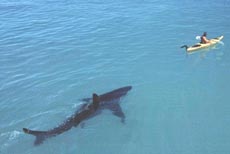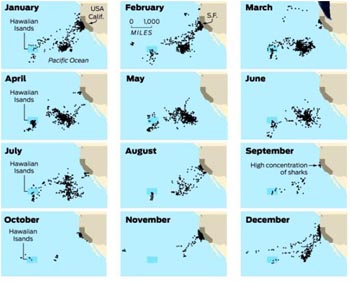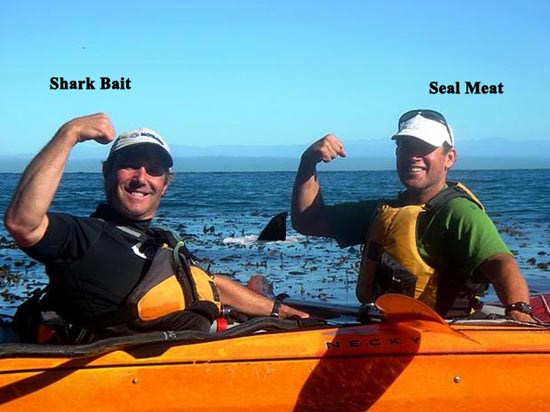
Great White Shark (Carcharadon carcharias) attacks along the California coastline are uncommon, yet stories of vicious attacks in areas like the Red Triangle perpetuate shark attack lore. Our fascination and fear of these ocean predators holds our interest and remains in the back of our minds - especially when kayaking in shark-infested waters.
On day three of paddling one member of our group (Bridget) started asking "What if" questions about a possible shark encounter. We reflected on these questions and developed the following, part fiction, part fact guide to safely navigating dorsal fins near Santa Cruz Island.
Step 1: Know when sharks are present. Migratory shark behavior helps determine the likelihood of encounters. From September through February, shark activity is high along the California coastline. In the spring, sharks migrate toward the Hawaiian Islands providing a window for shark-free sea kayaking in California[1]. We kayaked in September, but we are brave[2].
Step 2: Know what sharks like to eat. Shark diet near Santa Cruz Island consists of seals, limited sea lions, and various types of fish. Keep your distance from these animals. Even if you think the seals are cute and want to take your picture with them, they are shark magnets in disguise.
Step 3: Follow the Do List and abstain from the Don't List. Your ability to remain safe in shark-infested waters depends on planning, staying calm and following these simple rules. They are developed from internet searches, myths and media reports, but none-the-less, if you have nothing else to go by these rules will, at the minimum, afford you some sense of security, false or otherwise.

The DO List:
- Kayak at the right time of the year (April, May and June).
- Paddle slowly and smoothly.
- Sharks use their vibration-sensitive lateral line to sense movement and sensory organs to detect electrical signals from muscular activity. Slow, steady paddling, or swimming, will attract less attention.
- Kayak in a light grey or blue boat.
- High contrast colors may attract sharks according to George H. Burgess, of the International Shark Attack File at the Florida Museum of Natural History, University of Florida.3 4
- Paddle in groups and stay within shouting distance.
- The big danger is flipping over, this makes you dangle in the water like a piñata full of shark-candy. Having friends nearby to help you right yourself or get back into your boat will improve your chances of survival.
The DON'T List:
- Chum the waters around you to attract fish.
- Shark's sense of smell is nothing short of miraculous. If you can attract sport fish with chum, then you can definitely attract sharks.
- Release bodily fluids into the water (blood, urine, or vomit).
- Remember that sense of smell? They use it to detect prey, but also to detect the mental state of their prey. Scared and injured animals release bodily fluids - this is like an olfactory dinner bell for a shark.
- Allow fish to flop around inside your kayak.
- Sharks have an acute sense of hearing, and a kayak hull acts like an amplifier. You may not think it's loud, but to a shark, a fish flopping around in your kayak is clear for hundreds of yards.
- Panic.
- Always a bad idea, and sometimes difficult to control (see intro photo). The best defense against panic is preparation and forethought. Have a plan and visualize yourself reaching shore without losing your life or your dignity.
To conclude, sharks are at the top of the marine food chain in coastal California waters. People are mere visitors. It is your decision to sea kayak in this environment. However, if you follow these guidelines, you stand a better chance of not encountering a shark, or paddling home with a scary story instead of a missing body part. Now get out there and have a good time!

NOTES
1 Shark migration map adapted from San Francisco Chronicle. "Great white sharks swarm to area in summer." Peter Fimriete (09/15/2010).
2 Actually, we didn't have a choice
3 http://www.flmnh.ufl.edu/fish/sharks/isaf/color.htm
4 Contrary to the oft-repeated myth, sharks are not color blind.
